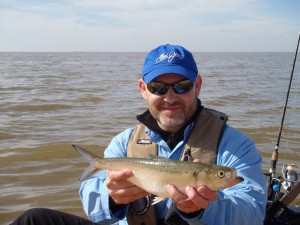 Sometimes disappointment needs unwrapped to discover something so much better. Monday, I was fishing Mobile Bay in my Hobie Outback kayak. As I mentioned in the last blog entry, January is not the month I lead with the fly. So, upon a routine cast of a white soft plastic curly tail on a 1/8 oz jighead with my 7′ Medium TFO Signature Series baitcasting rod, a sudden thud rushed anticipation through my left arm and into my recently reconstructed shoulder.
Sometimes disappointment needs unwrapped to discover something so much better. Monday, I was fishing Mobile Bay in my Hobie Outback kayak. As I mentioned in the last blog entry, January is not the month I lead with the fly. So, upon a routine cast of a white soft plastic curly tail on a 1/8 oz jighead with my 7′ Medium TFO Signature Series baitcasting rod, a sudden thud rushed anticipation through my left arm and into my recently reconstructed shoulder.
The fish leaped in the air and gave a good long fight until finally brought into the kayak. When I lifted the fish out of the water, my first impression was focused on the silver colored sides and hook jaw that resembled a juvenile tarpon. Could this be my second baby tarpon caught in waters of Mobile Bay in last year and a half?
 After a few pictures and release of fish, I went on fishing and was already thinking forward to a story of yet another tarpon caught and released in home waters. After arriving home later and sharing the day’s events, I had some feedback that the fish didn’t look quite right for a tarpon. So, after receiving input from friends, I made inquiry to the knowledgeable folks at the Alabama State Marine Resources Division. After being convinced by friends I hadn’t caught a tarpon and doing some further research, I wasn’t 100% sure whether I had caught a Skipjack herring, Alosa chrysochloris or an Alabama shad, Alosa alabamae. A quick reply gave definitive feedback that the fish I had caught was the Skipjack herring, Alosa chrysochloris. The first of a new species on my list of fish caught.
After a few pictures and release of fish, I went on fishing and was already thinking forward to a story of yet another tarpon caught and released in home waters. After arriving home later and sharing the day’s events, I had some feedback that the fish didn’t look quite right for a tarpon. So, after receiving input from friends, I made inquiry to the knowledgeable folks at the Alabama State Marine Resources Division. After being convinced by friends I hadn’t caught a tarpon and doing some further research, I wasn’t 100% sure whether I had caught a Skipjack herring, Alosa chrysochloris or an Alabama shad, Alosa alabamae. A quick reply gave definitive feedback that the fish I had caught was the Skipjack herring, Alosa chrysochloris. The first of a new species on my list of fish caught.
Upon review of the Kayak Fishing World Records, managed by YakAngler.com, it was clear that I may have an opportunity at claiming my second record. Indeed, after submitting application with accompanying photos, I received notification today that I am the new Kayak Fishing World Record Holder for the species of Skipjack herring, Alosa chrysochloris!
Link to record: http://www.yakangler.com/length-record-list/item/2860-herring-skipjack

“There is the sea, vast and spacious, teeming with creatures beyond number – living things large and small.” –Psalm 104:25
Today, I am thankful for a small creature that gave me a big smile and a story to tell.

Thank you to Kayak Angler Magazine for also running this story: https://www.rapidmedia.com/kayak-fishing/categories/news/2322-kayak-fishing-world-record%E2%80%93skipjack-herring.html
Copyright 2014 by icastinayak.com. All rights reserved


